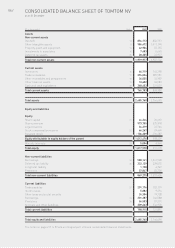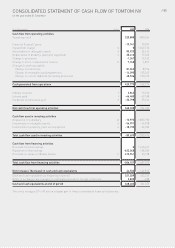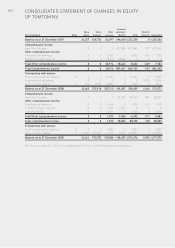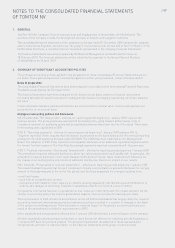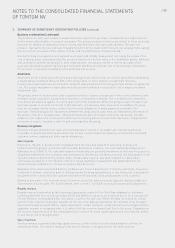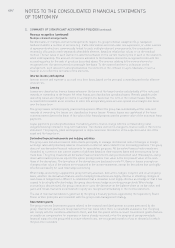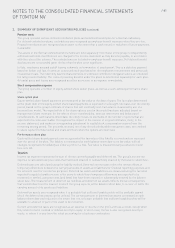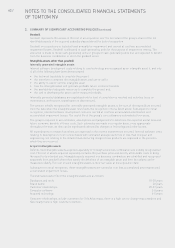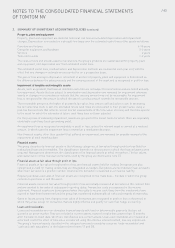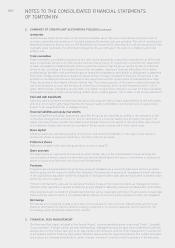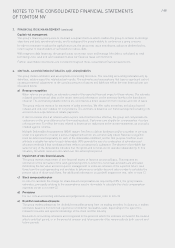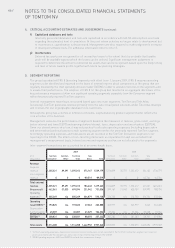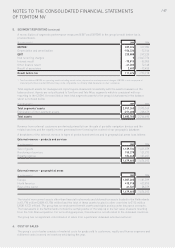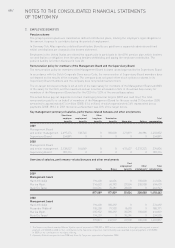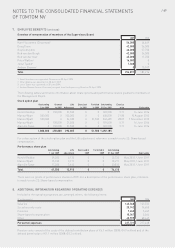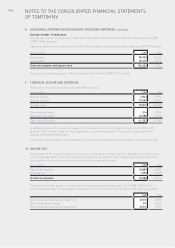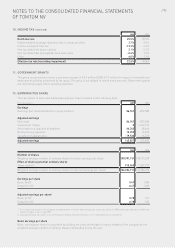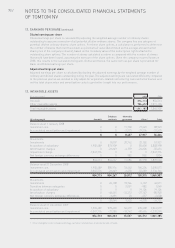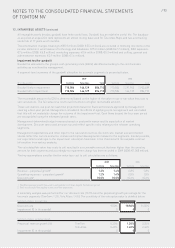TomTom 2009 Annual Report Download - page 65
Download and view the complete annual report
Please find page 65 of the 2009 TomTom annual report below. You can navigate through the pages in the report by either clicking on the pages listed below, or by using the keyword search tool below to find specific information within the annual report.
/ 63
NOTES TO THE CONSOLIDATED FINANCIAL STATEMENTS
OF TOMTOM NV
2. SUMMARY OF SIGNIFICANT ACCOUNTING POLICIES (continued)
Property, plant and equipment
Property, plant and equipment are stated at historical cost less accumulated depreciation and impairment
charges. Depreciation is recorded on a straight-line basis over the estimated useful lives of the assets as follows:
Furniture and fixtures 4-10 years
Computer equipment and hardware 2-4 years
Vehicles 4 years
Tools and moulds 1-2 years
The costs of tools and moulds used to manufacture the group’s products are capitalised within property, plant
and equipment, and depreciated over their estimated useful lives.
The estimated useful lives, residual values and depreciation methods are reviewed at each year end, with the
effect that any changes in estimate are accounted for on a prospective basis.
The gain or loss arising on disposal or retirement of an item of property, plant and equipment is determined as
the difference between the sales proceeds and the carrying amount of the asset and is recognised in profit or loss.
Impairment of tangible and intangible assets
Assets, such as goodwill, that have an indefinite useful life are not subject to amortisation and are tested annually
for impairment. Assets that are subject to amortisation and depreciation are reviewed for impairment whenever
events or changes in circumstances indicate that the carrying amount may not be recoverable. An impairment
loss is recognised for the amount by which the asset’s carrying amount exceeds its recoverable amount.
The recoverable amount is the higher of an asset’s fair value, less costs to sell and value in use. In estimating
the fair value less costs to sell, the estimated future cash flows are discounted to their present value, using a
post-tax discount rate that reflects current market assessments of the time-value of money and the risks specific
to the asset for which the estimates of future cash flows have not been adjusted.
For the purposes of assessing impairment, assets are grouped at the lowest levels for which there are separately
identifiable cash flows (cash-generating units).
An impairment loss is recognised immediately in profit or loss, unless the relevant asset is carried at a revalued
amount, in which case the impairment loss is treated as a revaluation decrease.
Non-financial assets, other than goodwill that suffered an impairment, are reviewed for possible reversal of the
impairment at each reporting date.
Financial assets
The group classifies its financial assets in the following categories: at fair value through profit or loss (held for
trading) and loans and receivables. The classification depends on the purpose for which the financial assets were
acquired. Management determines the classification of its financial assets at initial recognition. The fair values
and classification of the financial instruments used by the group are disclosed in note 33.
Financial assets at fair value through profit or loss
Financial assets at fair value through profit or loss are financial assets held for trading. Derivatives are also
categorised as held for trading unless they are designated as hedges. Derivatives are recorded as financial assets
when their fair value is a positive number; otherwise the derivative is classified as a financial liability.
Regular purchases and sales of financial assets are recognised on the trade date – the date in which the group
commits to purchase or sell the asset.
Financial assets carried at fair value through profit or loss are initially measured at fair value on the contract date
and are marked to fair value at subsequent reporting dates. Transaction costs are expensed in the income
statement. Financial assets are derecognised when the rights to receive cash flows from the investments have
expired or have been transferred and the group has transferred substantially all risks and rewards of ownership.
Gains or losses arising from changes in fair value of derivatives are recognised in profit or loss in the period in
which they arise, except for derivatives that are highly effective and qualify for cash flow hedge accounting.
Loans and receivables
Loans and receivables are non-derivative financial assets with fixed or determinable payments that are not
quoted in an active market. They are included in current assets, except for maturities greater than 12 months
after the balance sheet date, which are classified as non-current assets. Loans and receivables are measured at
amortised cost (if the effect of time value is material) using the effective interest method, less any impairment.
The group’s financial assets classified in the category loans and receivables comprise ‘trade receivables’ and
‘cash and cash equivalents’ in the balance sheet (notes 17 and 20).



